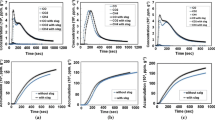Abstract
Activated carbon wastes from the air cleaning system in a nuclear facility contain a long half-life value of 14C (5700 years). This 14C is converted into a gaseous form of 14CO2 during a treatment process of the activated carbon wastes, and it is vented with a considerable amount of CO2 gas. This CO2 gas must be immobilized in a stable waste form with a minimized volume for final disposal. For this reason, carbonation tests of CO2 were conducted in accelerated CO2 carbonation equipment using Ca(OH)2, and fabrication tests of the CO2 carbonation products into a waste form were performed using a low melting glass in this study. Through the carbonation tests, an optimal condition was determined to achieve a high CaCO3 production rate (214 kg/m3 h). In the fabrication tests, it was confirmed that the carbonation product can be fabricated into a homogenous glass-ceramic waste form with a high density (3.1 g/cm3) at 450 °C by using a low melting glass with the Bi2O3–B2O3–ZnO–SiO2 system.













Similar content being viewed by others
References
Huve J, Ryzhikov A, Nouali H, Lalia V, Augé G, Jean Daou T (2018) Porous sorbents for the capture of radioactive iodine compound: a review. RCS Adv 8:29248–29273
So J, Cho H (2017) Thermal characteristics of spent activated carbon generated from air cleaning units in Korean nuclear power plants. Nucl Eng Technol 49:873–880
Korea Atomic Energy Research Institute (2008) Development of the process for decontaminating 14C & 3H in the waste activated carbon from air cleaning system. Report No. KAERI/CR-316/2008
Sanna A, Uibu M, Caramanna G, Kuusik R, Maroto-Valer MM (2014) A review of mineral carbonation technologies to sequester CO2. Chem Soc Rev 43:8049–8080
Ukwattage NL, Gamage RP, Wang SH (2013) Investigation of the potential of coal combustion fly ash for mineral sequestration of CO2 by accelerated carbonation. Energy 52:230–236
Harrison LA, Power IM, Dipple GM (2013) Accelerated carbonation of brucite in mine tailing for carbon sequestration. Environ Sci Technol 47:126–134
Montes-Hernandez G, Pérez-López R, Renard F, Nieto JM, Charlet L (2009) Mineral sequestration of CO2 by aqueous carbonation of coal combustion fly ash. J Hazard Mater 161:1347–1354
Montes-Hernandez G, Renard F, Geoffroy N, Charlet L, Pironon J (2007) Calcite precipitation from CO2-H2O-Ca(OH)2 slurry under high pressure of CO2. J Crystal Growth 308:228–236
Murakami FS, Rodrigues PO, de Campos CMT, Silva MAS (2007) Physicochemical study of CaCO3 from egg shells. Food Sci Technol 27(3):658–662
Li X, Iv Y, Ma B, Jian S (2017) Decomposition kinetic characteristics of calcium carbonate containing organic acids by TGA. Arabian J Chem 10:S2534–S2538
Yim M, Caron F (2006) Life cycle and management of carbon-14 from nuclear power generation. Prog Nucl Energy 48:2–36
Chen M, Juuti J, His C, Chia C, Jantunen H (2015) Dielectric properties of ultra-low sintering temperature Al2O3-BBSZ glass composite. J Am Ceram Soc 98(4):1133–1136
Sebastian MT, Wang H, Jantunen H (2016) Low temperature co-fired ceramics with ultra-low sintering temperature: a review. Curr Opin Sol State Mater Sci 20(3):151–170
Laboureur L, Ollero M, Touboul D (2015) Lipidomics by supercritical fluid chromatography. Int J Mol Sci 16:13868–13884
Khanam M, Daim TU (2017) A regional technology roadmap to enable the adoption of CO2 heat pump water heater: A case from the Pacific Northwest, USA. Energy Strategy Rev 18:157–174
Lackner KS, Brennan S (2009) Envisioning carbon capture and storage: expanded possibilities due to air capture, leakage insurance, and C-14 monitoring. Clim Change 96:357–378
Zuritz CA, Puntes EM, Mathey HH, Pérez EH, Gascón A, Rubio LA, Carullo CA, Chernikoff RE, Cabeza MS (2005) Density, viscosity and coefficient of thermal expansion of clear grape juice at different soluble solid concentrations and temperatures. J Food Eng 71:143–149
Bandaiphet C, Prasertsan P (2006) Effect of aeration and agitation rates and scale-up on oxygen transfer coefficient, kL in exopolysaccharide production from Enterobacter cloacae WD7. Carb Pol 66:216–228
Cheeseman CR, Asavapisit S, Knight J (1998) Effect of uniaxially pressing ordinary Portland cement pastes containing metal hydroxides on porosity, density, and leaching. Cem Concr Res 28(11):1639–1653
Acknowledgements
The authors would like to express their appreciation for the support provided by the National Research Foundation of Korea (NRF), which is funded by the Ministry of Science, ICT and Future Planning (MSIP) of the Republic of Korea (NRF- 2017M2A8A5015147).
Author information
Authors and Affiliations
Corresponding author
Additional information
Publisher’s note
Springer Nature remains neutral with regard to jurisdictional claims in published maps and institutional affiliations.
Rights and permissions
About this article
Cite this article
Eun, HC., Yang, HC., Kim, HJ. et al. A study on immobilization of 14CO2 using inorganic materials. J Radioanal Nucl Chem 328, 627–635 (2021). https://doi.org/10.1007/s10967-021-07681-4
Received:
Accepted:
Published:
Issue Date:
DOI: https://doi.org/10.1007/s10967-021-07681-4




